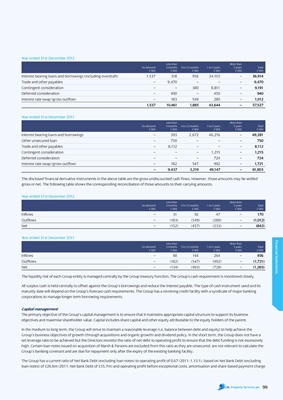
Year ended 31st December 2012
Less than More than
On demand 3 months 3 to 12 months 1 to 5 years 5 years Total
£’000 £’000 £’000 £’000 £’000 £’000
Interest bearing loans and borrowings (including overdraft) 1,537 318 956 34,103 – 36,914
Trade and other payables – 9,470 – – – 9,470
Contingent consideration – – 380 8,811 – 9,191
Deferred consideration – 490 – 450 – 940
Interest rate swap (gross outflow) – 183 549 280 – 1,012
1,537 10,461 1,885 43,644 – 57,527
Year ended 31st December 2011
Less than More than
On demand 3 months 3 to 12 months 1 to 5 years 5 years Total
£’000 £’000 £’000 £’000 £’000 £’000
Interest bearing loans and borrowings – 393 2,672 46,216 – 49,281
Other unsecured loan – 750 – – – 750
Trade and other payables – 8,112 – – – 8,112
Contingent consideration – – – 1,215 – 1,215
Deferred consideration – – – 724 – 724
Interest rate swap (gross outflow) – 182 547 992 – 1,721
– 9,437 3,219 49,147 – 61,803
The disclosed financial derivative instruments in the above table are the gross undiscounted cash flows. However, those amounts may be settled
gross or net. The following table shows the corresponding reconciliation of those amounts to their carrying amounts.
Year ended 31st December 2012
Less than More than
On demand 3 months 3 to 12 months 1 to 5 years 5 years Total
£’000 £’000 £’000 £’000 £’000 £’000
Inflows – 31 92 47 – 170
Outflows – (183) (549) (280) – (1,012)
Net – (152) (457) (233) – (842)
Year ended 31st December 2011
Financial Statements
Less than More than
On demand 3 months 3 to 12 months 1 to 5 years 5 years Total
£’000 £’000 £’000 £’000 £’000 £’000
Inflows – 48 144 264 – 456
Outflows – (182) (547) (992) – (1,721)
Net – (134) (403) (728) – (1,265)
The liquidity risk of each Group entity is managed centrally by the Group treasury function. The Group’s cash requirement is monitored closely.
All surplus cash is held centrally to offset against the Group’s borrowings and reduce the interest payable. The type of cash instrument used and its
maturity date will depend on the Group’s forecast cash requirements. The Group has a revolving credit facility with a syndicate of major banking
corporations to manage longer term borrowing requirements.
capital management
The primary objective of the Group’s capital management is to ensure that it maintains appropriate capital structure to support its business
objectives and maximise shareholder value. Capital includes share capital and other equity attributable to the equity holders of the parent.
In the medium to long term, the Group will strive to maintain a reasonable leverage (i.e. balance between debt and equity) to help achieve the
Group’s business objectives of growth (through acquisitions and organic growth) and dividend policy. In the short term, the Group does not have a
set leverage ratio to be achieved but the Directors monitor the ratio of net debt to operating profit to ensure that the debt funding is not excessively
high. Certain loan notes issued on acquisition of Marsh & Parsons are excluded from this ratio as they are unsecured, are not relevant to calculate the
Group’s banking covenant and are due for repayment only after the expiry of the existing banking facility.
The Group has a current ratio of Net Bank Debt (excluding loan notes) to operating profit of 0.67 (2011: 1.15:1), based on Net Bank Debt (excluding
loan notes) of £26.6m (2011: Net Bank Debt of £35.7m) and operating profit before exceptional costs, amortisation and share-based payment charge
99